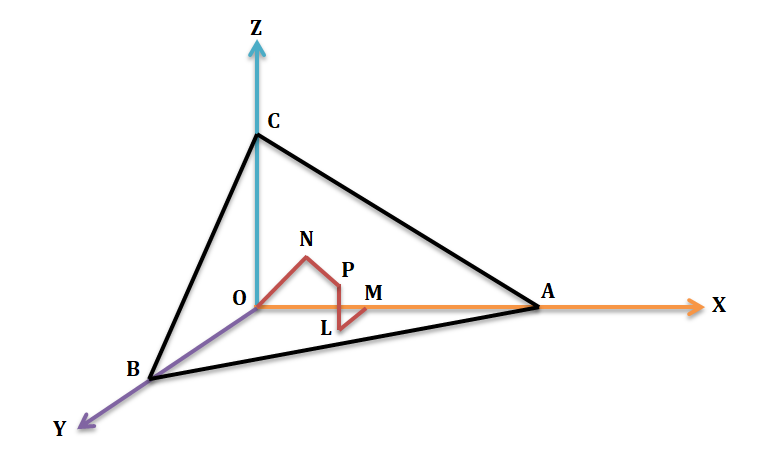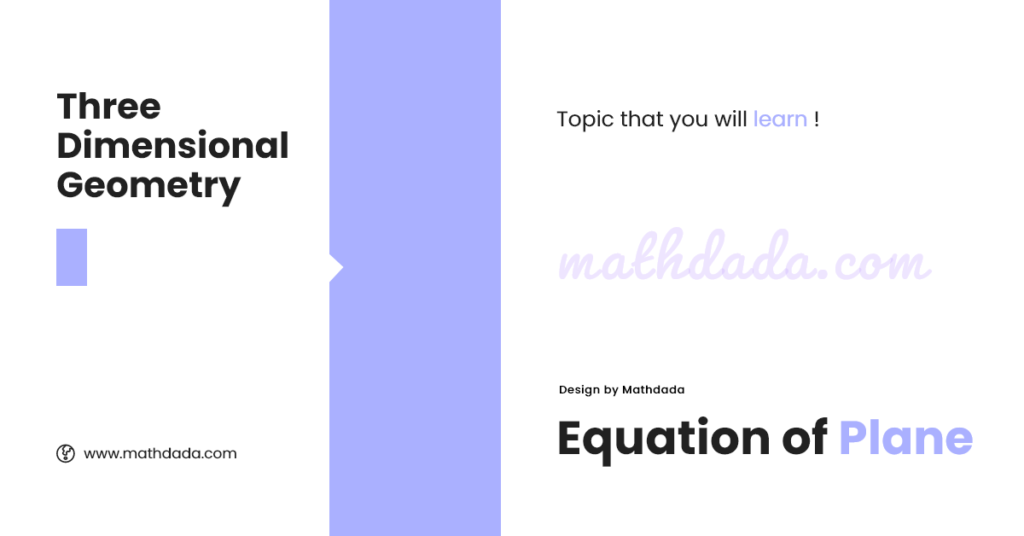Table of Contents
The Plane
A first degree equation in x, y, z represents a plane. The most general equation of the first degree is ax+by+cz+d=0 where a, b, c, d are real constants and a2 + b2 +c2 ≠ 0. This equation is called the Equation of Plane.
If P(x1, y1, z1) and Q(x2, y2, z2) be any two points on the locus, then we get
\[a{{x}_{1}}+b{{y}_{1}}+c{{z}_{1}}+d=0\,\,and\,\,a{{x}_{2}}+b{{y}_{2}}+c{{z}_{2}}+d=0\]
Multiplying the first by \frac{n}{m+n} and the second by \frac{m}{m+n} and adding them we get
\[a\frac{m{{x}_{2}}+n{{x}_{1}}}{m+n}+b\frac{m{{y}_{2}}+n{{y}_{1}}}{m+n}+c\frac{m{{z}_{2}}+n{{z}_{1}}}{m+n}+d=0\]
This shows that the co-ordinates of the point dividing PQ in any ration m:n satisfy the equation of the locus. Therefore the straight line PQ lies entirely on the locus. This shows that the locus satisfies Euclid’s definition of a plane, namely a plane is a surface such that if any two points be taken on it, the straight line joining them lies wholly on the surface.
Cor. 1. Equation of plane passing through the point (x1, y1, z1) is
\[a\left( x-{{x}_{1}} \right)+b\left( y-{{y}_{1}} \right)+c\left( z-{{z}_{1}} \right)=0\]
Cor. 2. The two equations a{{x}_{1}}+b{{y}_{1}}+c{{z}_{1}}+d=0\,\,and\,\,a{{x}_{2}}+b{{y}_{2}}+c{{z}_{2}}+d=0 will represent the same plane if and only if
\[\frac{{{a}_{1}}}{{{a}_{2}}}=\frac{{{b}_{1}}}{{{b}_{2}}}=\frac{{{c}_{1}}}{{{c}_{2}}}=\lambda \,\left( \ne 0\,and\,real \right)\]
Cor. 3. Equations of the co-ordinate planes are x = 0, y = 0 and z = 0.
Cor. 4. Equation of planes parallel to the co-ordinate planes are x = constant, y = constant, z = constant.
These planes are perpendicular to the axes.
Equation of planes parallel to the x-axes, y-axes and z-axes are respectively of the form by + cz + d = 0, ax + cz + d = 0 and ax + by + d = 0. These planes are perpendicular to the yz-plane, zx-plane and xy-plane respectively.
Cor. 5.
(i) If d = 0, then the plane passes through the origin.
(ii) If a = 0, then the plane is parallel to x-axes.
(iii) If a = b = 0, then the plane is parallel to the xy-plane.
(iv) If a = b = c = 0 but d is finite, then the plane is at an infinite distance; since, in that case, the x-axis (y = z = 0) meets the plane ax + by + cz + d = 0 at y = 0, z = 0, ax + d = 0.
The x-co-ordinate of the point of intersection is given by \left( -\frac{d}{a} \right).
If now a be indefinitely diminished while d remain finite, then the x-axis cuts the plane at an infinite distance. The same being true for the other axes.
Hence the plane is at an infinite distance from the origin.
Note: The equation of plane can be put in the form lx + my + nz = 1 having only three constants l, m, n. Hence a plane can be found to satisfy three conditions. On the other hand, if three conditions be given, then a plane can be found completely.
Equation of plane in different forms
(a) Normal Form:

Let ON is the perpendicular from the origin O to the plane ABC. If the normal ON makes angles α, β, γ with the axes of x, y, z respectively and p is the length of the perpendicular ON, then the equation of the plane is
\[x\cos \alpha +y\cos \beta +z\cos \gamma =p\]
By comparing the general equation of the first degree ax + by + cz + d = 0 we find the length of the perpendicular from the origin to the plane is \frac{d}{\sqrt{{{a}^{2}}+{{b}^{2}}+{{c}^{2}}}}.
The sign with the radical is taken to be positive or negative according as d is negative or positive, because p is taken to be positive by convention.
(b) Intercept Form:
Let the equation of plane be
Ax+By+Cz+D=0..........\left( 1 \right)Let it make intercepts a, b, c on the co-ordinate axes. Then the points (a, 0, 0), (0, b, 0), (0, 0,c) lie on the plane and their co-ordinates must satisfy the equation (1)
So, the equation (1) in intercepted form
\frac{x}{a}+\frac{y}{b}+\frac{c}{z}=1,\,\left( none\,\,of\,\,a,b,c\,\,is\,\,zero \right)
Planes passing through three given points
Let ax + by + cz + d = 0 be the equation of the passing through the points (x1, y1, z1), (x2, y2, z2) and (x3, y3, z3).
Then equation of the plane passing through the above three points is

Angle between two planes
Let the two planes be a1x + b1y + c1z + d1 = 0 and a2x + b2y + c2z + d2 = 0. Let θ be the angle between the two planes. Then this must be the angle between their normal.
The direction ratios of the normals of the two planes are (a1, b1, c1) and (a2, b2, c2). Hence, if θ be the angle between them, then
\[\cos \theta =\frac{{{a}_{1}}{{a}_{2}}+{{b}_{1}}{{b}_{2}}+{{c}_{1}}{{c}_{2}}}{\sqrt{a_{1}^{2}+b_{1}^{2}+c_{1}^{2}}.\sqrt{a_{2}^{2}+b_{2}^{2}+c_{2}^{2}}}\]
Cor. 1. If the two plane be perpendicular to each other, so are their normals whose direction cosines are proportional to (a1, b1, c1) and (a2, b2, c2). Hence the condition of perpendicularity of the two planes is
\[{{a}_{1}}{{a}_{2}}+{{b}_{1}}{{b}_{2}}+{{c}_{1}}{{c}_{2}}\]
Cor. 2. If the two planes be parallel, so are their normals. Hence the condition of parallelism of the two planes is
\[\frac{{{a}_{1}}}{{{a}_{2}}}=\frac{{{b}_{1}}}{{{b}_{2}}}=\frac{{{c}_{1}}}{{{c}_{2}}}\]
| Example 01 |
Find the equation of the plane passing through the three points (2, 2, – 1), (3, 4, 2) and (7, 0, 6).
Solution:
The equation of plane passing through the point (2, 2, – 1) is
\[A\left( x-2 \right)+B\left( y-2 \right)+C\left( z+1 \right)=0……….\left( 1 \right)\]
If it passes through the points (3, 4, 2) and (7, 0, 6), then we have
\[A+2B+3C=0\,……….\left( 2 \right)\]
\[5A-2B+7C=0\,………..\left( 3 \right)\]
Eliminating A, B and C from (1), (2) and (3), we get the equation of the required plane as

| Example 01 |
Find the equation of plane which passes through the point (2, 1, – 1) and is orthogonal to each of the planes x-y+z=1\,\,and\,\,3x+4y-2z=0.
Solution:
Let the equation of the plane be ax+by+cz+d=0
If the plane passes through the point (2, 1, – 1), then we have
\[2a+b-c+d=0\,……….\left( 1 \right)\]
Moreover, if the plane be orthogonal to each of the planes x-y+z=1\,\,and\,\,3x+4y-2z=0. Then we have
\[a-b+c=0\,……….\left( 2 \right)\]
\[3a+4b-2c=0\,……….\left( 3 \right)\]
From (2) and (3), by cross-multiplication, we have
\[\frac{a}{2-4}=\frac{b}{3+2}=\frac{c}{4+3}=k\,\left( say \right)\]
\[\therefore \,\,a=-2k,\,\,b=5k\,\,and\,\,c=7k.\]
Putting these values in (1), we have
\[-4k+5k-7k+d=0\]
\[\Rightarrow \,d=6k\]
Hence the required equation of plane is
\[-2kx+5ky+7kz+6k=0\]
\[\Rightarrow 2x-5y-7z-6=0\]
Rectangular Cartesian |
Straight Lines |


